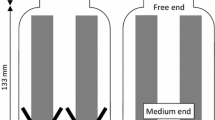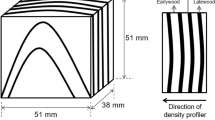Abstract
-
• Fungal attack in wood involves severe mechanical losses, even in the early stages, due to depolymerisation of polysaccharides. The safety of building components could therefore be affected. It is believed that fracture properties could be much more sensitive to decay than conventionally measured properties, such as weight loss.
-
• In this study, we propose the application of a fracture mechanics test, which measures the fracture toughness, K IC , during the biodegradation process. Two softwoods commonly used in construction, maritime pine and Douglas fir, were inoculated with Poria placenta. Samples were removed twice a week to determine the evolution of the decrease in their mechanical properties.
-
• Toughness was initially greater for maritime pine, but a significant decrease of this property was observed during decay progression, while K IC remained more stable for Douglas fir. For maritime pine there was a loss of 52% of K IC , after 6 weeks of degradation. This species appears to be less durable even with respect to weight loss, which is less sensitive to decay than toughness.
-
• This is a promising test for bio-damage quantification; however, due to the wood heterogeneity, measurement of the true impact of biodegradation is still difficult.
Similar content being viewed by others
References
AFNOR, 1994. NF EN 350-1, Durabilité du bois et des matériaux dérivés du bois — Durabilité naturelle du bois massif — Partie 1: Guide des principes d’essai et de classification de la durabilité naturelle du bois. Association Française de Normalisation, La Plaine Saint-Denis, 20 p.
AFNOR, 1996. NF EN 113, Produits de préservation du bois — Méthode d’essai pour déterminer l’efficacité protectrice vis-à-vis des champignons basidiomycètes lignivores — Détermination du seuil d’efficacité. Association Française de Normalisation, La Plaine Saint-Denis, 32 p.
ASTM-E399, 1990. Standard test method for plane-stain fracture toughness of metallic materials. ASTM International, West Conshohocken, PA, 33 p.
Bažant Z.P. and Planas J., 1998. Fracture and size effect in concrete and other quasibrittle materials, CRC Press, Boca Raton, Florida, 640 p.
Boatright S.W.J. and Garrett G.G., 1983. The effect of microstructure and stress state on the fracture behaviour of wood. J. Mater. Sci. 18: 2181–2199.
Cartwright K.S.G., Campbell W.G., and Armstrong F.H., 1936. The influence of fungal decay on the properties of timber. I. The effect of progressive decay by Polyporus hispidus, Fr., on the strength of english ash (Fraxinus excelsior, L.). Biol. Sci. 120: 76–95.
Castéra P., Nepveu G., and Chantre G., 1999. Principaux facteurs de contrôle de la variabilité du bois chez le pin maritime (Pinus pinaster Ait.). In: 5e colloque ARBORA: Propriétés et usages du pin maritime, ARBORA, Bordeaux, pp. 91–101.
Clausen C.A. and Kartal S.N., 2003. Accelerated detection of brown-rot decay: Comparison of soil block test, chemical analysis, mechanical properties, and immunodetection. For. Prod. J. 53: 90–94.
Clausen C.A. and Yang V., 2007. Protecting wood from mould, decay, and termites with multi-component biocide systems. Int. Biodeter. Biodegr. 59: 20–24.
Donaldson L.A., 1992. Lignin distribution during latewood formation in Pinus radiata D. Don. IAWA Bull. 13: 381–387.
Gui Y.Q., Nicholas D.D., and Crawford D., 1996. A miniature mechanical apparatus and test protocol for bending and crushing tests in wood preservation research. For. Prod. J. 46: 77–80.
Humar M., Bucar B., and Pohleven F., 2006. Brown-rot decay of copper-impregnated wood. Int. Biodeter. Biodegr. 58: 9–14.
Irbe I., Andersons B., Chirkova J., Kallavus U., Andersone I., and Faix O., 2006. On the changes of pinewood (Pinus sylvestris L.) Chemical composition and ultrastructure during the attack by brown-rot fungi Poria placenta and Coniophora puteana. Int. Biodeter. Biodegr. 57: 99–106.
Knapic S. and Pereira H., 2005. Within-tree variation of heartwood and ring width in maritime pine (Pinus pinaster Ait.). For. Ecol. Manage. 210: 81–89.
Machado J.S. and Cruz H.P., 2005. Within stem variation of maritime pine timber mechanical properties. Holz Roh Werkst. 63: 154–159.
Morel S., Dourado N., Valentin G., and Morais J., 2005. Wood: a quasi brittle material, R-curve behavior and peak load evaluation. Int. J. Fract. 131: 385–400.
Nepveu G., 1994. Variabilité. In: Jodin P. (Ed.), Le Bois, Matériau d’Ingénierie, ARBOLOR, Nancy, pp. 127–182.
Plomion C., Leprovost G., and Stokes A., 2001. Wood formation in trees. Plant Physiol. 127: 1513–1523.
Pot D., Chantre G., Rozenberg P., Rodrigues J.C., Jones G.L., Pereira H., Hannrup B., Cahalan C., and Plomion C., 2002. Genetic control of pulp and timber properties in maritime pine (Pinus pinaster Ait.). Ann. For. Sci. 59: 563–575.
Przewloka S.R., 2004. Comparison of rapid decay testing methodologies for the screening of new wood preservatives. PG04-5015, Forest and Wood Products Research and Development Corporation, Denis M Cullity Research Fellowship Report, 88 p.
Reiterer A. and Sinn G., 2002. Fracture behaviour of modified spruce wood: a study using linear and non linear fracture mechanics. Holzforschung 56: 191–198.
Ritschkoff A.-C., 1996. Decay mechanisms of brown-rot fungi. VTT Publications No. 268, Technical Research Centre of Finland, Espoo, 105 p.
Schniewind A.P. and Centeno J.C., 1973. Fracture toughness and duration of load factor I. Wood Fiber Sci. 5: 152–159.
Stanzl-Tschegg S.E., Tschegg E.K., and Teischinger A., 1994. Fracture energy of spruce wood after different drying procedures. Wood Fiber Sci. 26: 467–478.
Stanzl-Tschegg S.E., Tan D.M., and Tschegg E.K., 1996. Fracture resistance to the crack propagation in wood. Int. J. Fract. 75: 347–356.
Winandy J.E. and Morrell J.J., 1993. Relationship between incipient decay, strength, and chemical composition of Douglas-fir heartwood. Wood Fiber Sci. 25: 278–288.
Winandy J.E., Clausen C.A., and Curling S.F., 2000. Predicting the effects of decay on wood properties and modeling residual service-life. In: Proc. 2nd annual conference on durability and disaster mitigation in wood-frame housing, Forest Products Society, Madison, WI, pp. 261–263.
Winandy J.E. and Lebow P., 2001. Modeling Strength Loss in Wood by Chemical Composition. Part I. an Individual Component Model for Southern Pine. Wood Fiber Sci. 33: 239–254.
Woessner P., 2008. Influence d’un traitement thermique sur la résistance mécanique du bois de pin. M.S. thesis, Université Bordeaux 1, Bordeaux, 126 p.
Zabel R.A. and Morrell J.J., 1992. Wood microbiology. Decay and its prevention, San Diego, New York, 476 p.
Author information
Authors and Affiliations
Corresponding author
Rights and permissions
About this article
Cite this article
Surini, T., Chaplain, M., Castera, P. et al. Crack propagation in biodegraded wood. Ann. For. Sci. 67, 704 (2010). https://doi.org/10.1051/forest/2010029
Received:
Accepted:
Issue Date:
DOI: https://doi.org/10.1051/forest/2010029




